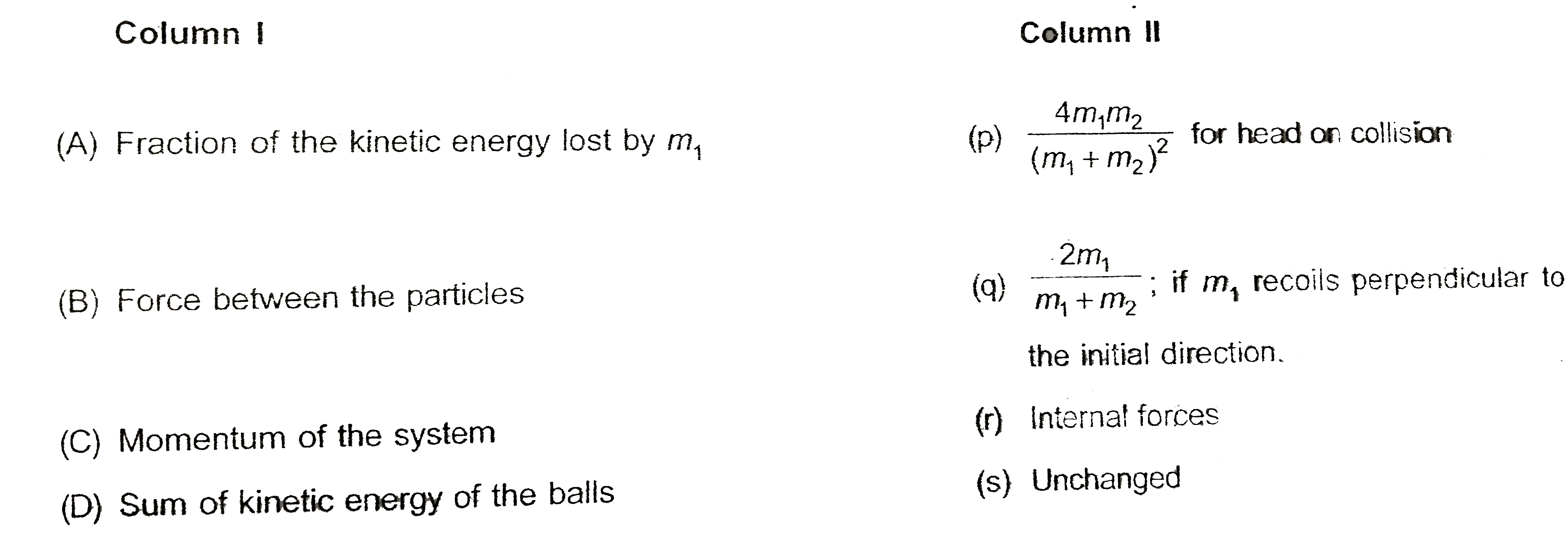A particle of mass m1 experiences a perfectlly elastic collision with a stationary particle of mass m2. Match the entires in column I to all the entires in column II.

Step by step video & image solution for A particle of mass m_(1) experiences a perfectlly elastic collision with a stationary particle of mass m_(2). Match the entires in column I to all the entires in column II. by Physics experts to help you in doubts & scoring excellent marks in Class 12 exams.
Updated on:21/07/2023Topper's Solved these Questions
- SYSTEM OF PARTICLES AND ROTATIONAL MOTIONBOOK - AAKASH INSTITUTECHAPTER - SYSTEM OF PARTICLES AND ROTATIONAL MOTIONEXERCISE - Assignment (Section - G) Integar Type Questions
9 Videos
- SYSTEM OF PARTICLES AND ROTATIONAL MOTIONBOOK - AAKASH INSTITUTECHAPTER - SYSTEM OF PARTICLES AND ROTATIONAL MOTIONEXERCISE - Assignment (Section - H) Multiple True-False Type Questions
4 Videos
- SYSTEM OF PARTICLES AND ROTATIONAL MOTIONBOOK - AAKASH INSTITUTECHAPTER - SYSTEM OF PARTICLES AND ROTATIONAL MOTIONEXERCISE - Assignment (Section - E) Assertion-Reason Type Questions
12 Videos
- SEMICONDUCTOR ELECTRONICS: MATERIALS, DEVICES AND SIMPLE CIRCUITSBOOK - AAKASH INSTITUTECHAPTER - SEMICONDUCTOR ELECTRONICS: MATERIALS, DEVICES AND SIMPLE CIRCUITSEXERCISE - Assignment (Section-D (Assertion and reason))
5 Videos
- TEST 1BOOK - AAKASH INSTITUTECHAPTER - TEST 1EXERCISE - EXERCISE
9 Videos
Similar Questions
Match all the entries in column-I to all the entries in column-II

View SolutionA particle of mass m1 experienced a perfectly elastic collision with a stationary particle of mass m2. What fraction of the kinetic energy does the striking particle lose, if
(a) it recoils at right angles to its original motion direction,
(b) the collision is a head-on one?
View Solution
Knowledge Check
A particle (A) of mass m1 elastically collides with another stationary particle (B) of mass m2. Then :
Am1m2=12 and the particles fly a part in the opposite direction with equal velocities.Bm1m2=13 and the particles fly apart in the opposite direction with equal velocities.Cm1m2=21 and the collision angle between the particles is 60∘ symmetrically.Dm1m2=21 and the particles fly apart symmetrically at an angle 90∘A particle of mass m1=4kg moving at 6ˆims−1perfectly elastically with a particle of mass m2=2 moving at 3ˆims−1
AVelocity of centre of mass (CM) is 5ˆims−1BThe velocities of the particles relative to the centre of mass have same magnitude.CSpeed of individual particle before and after collision remains same.DThe velocity of particles relative to CM after collisioin are →v1f/cm=−ˆims−1,→v2f/cm=2ˆims−1A particle of mass m1 makes an elastic, one-dimensional collision with a stationary particle of mass m2.What fraction of the kinetic energy of m1 is carried away by m2?
Am1m2Bm2m1C2m1m2(m1+m2)2D4m1m2(m1+m2)2
A particle of mass m experienced an elastic collision with a stationary particle of mass 2m . What fraction of the kinetic energy does the striking particle lose if recoils at the right angles to its original motion direction.
View SolutionParticle 1 experiences a perfectly elastic collision with a stationary particle 2. Determine their mass ratio , if the particles fly symmetrically relative to the initial motion direction particle 1 with angle of divergence θ=60∘.
View SolutionParticle 1 experiences a perfectly collision with a staionary particle 2. Determine their mass ratio , if the particles move perpendicularly to each other.
View SolutionParticle 1 experiences a perfectly elastic collision with a stationary particle 2. Determine their mass ratio, if
(a) after a head-on collision the particles fly apart in the opposite directions with equal velocities,
(b) the particles fly apart symmetrically relative to the initial motion direction of particle I with the angle of divergence θ=60∘.
View SolutionA particle of mass m1 makes an elastic one dimensional collision with a stationary particle of mass m2.What fraction of the kinetic energy of m1 is carried away by m2?
View Solution
